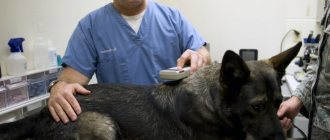Every person at least once in his life asked himself the question: “Why do people and animals walk upright and don’t fall?” The vestibular apparatus, which is a whole complex of structures united into a single system, is responsible for maintaining posture and orientation of the body in space relative to the horizontal.
A sudden imbalance causes vestibular syndrome, a neurological condition often diagnosed in pets.
Causes of the disease
Conventionally, vestibular syndrome is usually divided into peripheral and central, depending on which part is affected.
Also, this neurological phenomenon can be:
- metabolic;
- neoplastic;
- inflammatory;
- traumatic;
- toxic;
- idiopathic.
Accordingly, treatment will depend on the causes of vestibular syndrome.
The peripheral form is diagnosed quite rarely and occurs due to damage to the nervous system affecting the inner ear. The more common form is the central one, which is much more difficult. This is explained by the fact that not only the vestibular apparatus is affected, but also other systems of the body, so many pathologies are fraught with death.
The causes of vestibular syndrome include:
- inflammation in the inner and middle ear;
- abuse of ear cleaners;
- consequences of brain injuries;
- polyps, tumors;
- hormonal imbalances;
- meningoencephalitis;
- chaotic use of certain medications, in particular antibiotics.
Sometimes vestibular syndrome can be congenital or age-related - it is in such cases that we can talk about the idiopathic nature of the pathology, that is, when it occurs for no apparent reason.
Signs
Depending on the type of disease, the following pathological signs appear:
- Unsteady, as if drunk, gait. The dog moves in a straight line without any problems. But he is unable to turn or climb the stairs. Before making a turn, the animal crouches.
- The dog loses spatial orientation and bumps into objects it doesn’t notice. The feet move like a goose's. The dog places a limb, leans on it with its entire mass, and then puts out its second paw.
- The head and neck move fussily, too often, and the dog becomes dizzy. He falls, and the eyelids twitch characteristically. The attack resembles an epileptic seizure.
- The hallmark of ataxia is tremor. The dog's muscles suddenly begin to tremble, and the movements are not the same as during severe excitement or severe frost. When the pet moves or eats, the tremors intensify. As a result, food does not enter the mouth.
Main symptoms
The clinical picture of vestibular syndrome, often mistaken for a stroke, is quite extensive. The main sign to suspect pathology is loss of coordination in space. The dog begins to experience difficulty moving, walking with its head tilted, stumbling out of the blue, falling and spinning on the floor.
Another characteristic symptom is the occurrence of vertical nystagmus (eye twitching). In addition, the animal experiences salivation, uncontrollable vomiting, and dizziness.
In severe cases of the disease, the dog stops eating and begins to walk on its own. In such cases, the question of euthanasia is raised as the most humane option.
What is ataxia in dogs?
The presented pathology is of a genetic nature; it manifests itself only in those dogs that were the result of mating sick animals. Occurs mainly after damage to the cerebellum. Vestibular, cerebellar, and sensory ataxia is accompanied by impaired coordination of movements in the animal. With this disease, the dog may retain the strength of its limbs, however, it will not be able to move normally. The dog will constantly squat, fall, and roll to the side. The presented disease has a long course, in most clinical cases it leads to the premature death of the pet.
Ataxia is common in all regions. To avoid outbreaks of such a disease among representatives of a particular breed, dog owners, before breeding animals, do a genetic test for predisposition to the disease. If it turns out to be positive, the dog or bitch is not allowed to breed.
Diagnostics in a veterinary clinic
To make a correct diagnosis, the doctor, in addition to studying the medical history of the disease, needs to conduct the necessary diagnostic tests. These include:
- general and biochemical blood test;
- Analysis of urine;
- X-ray (to examine the middle and inner ear and assess their condition);
- MRI, CT (to determine possible structural changes in the brain);
- examination of scrapings from an animal's ear;
- a series of tests that determine the reaction of the nervous system to stimuli;
- collection of cerebrospinal fluid (to detect the virus in the body);
- Ultrasound of internal organs.
The veterinarian must rule out pathologies such as inflammation of the inner and middle ear, nasopharyngeal polyps, as well as the use of certain medications (aminoglycosides) that have serious side effects.
Types of ataxia
Based on the location of the problem, vestibular, cerebellar, sensory, sensitive, frontal and psychogenic types of ataxia in dogs are distinguished. They all have similar symptoms, but at the same time we must not forget about the characteristic differences.
Did you know? Translated from Greek, the name of the disease is understood as “disorder,” since the main manifestation of the disorder is erratic movement of the limbs and loss of body stability.
Vestibular
The vestibular type of ataxia is associated with lesions of the structures of the inner ear or brain stem, which disrupts the normal functioning of the vestibular apparatus as a whole. The main manifestations of such a disorder will be tilting the animal's head to the side, careful slow movements, dizziness and associated nausea. The dog may spin in circles or move chaotically in space.
Cerebellar
As the name suggests, this type of ataxia is associated with damage to the main center of coordination of motor activity - the cerebellum. It coordinates the animal's intentions to perform a specific movement with the further work necessary to successfully complete the process. Cerebellar ataxia manifests itself in dysmetria and symmetrical ataxia of the trunk, due to which the dog tries to spread its paws wide, thus maintaining balance. In rare cases, a tilt of the head and movement of the animal in a circle is noticeable, which is also characteristic of the previous type of ataxia. If you look closely at the eyes, you will hardly be able to notice that your pet’s gaze is fixed on one point - usually the pupils quickly move up and down, and in rare cases they have different sizes on the right and left eyes.
Sometimes a sign of cerebellar ataxia is tremor of the limbs when the pet is moving or at rest. In the first case, the characteristic symptoms of the disorder often appear when the dog tries to reach the intended goal (for example, a bowl of food). Postural tremor, characteristic of a calm state, is expressed in swaying of the body from side to side.
Treatment method and prognosis
Treatment of vestibular syndrome is not possible in all cases. So, if we are talking about the idiopathic nature of the pathology (congenital or acquired with age), medications are prescribed to alleviate the animal’s condition.
Pathology caused by an inflammatory infectious process is treated with antibiotics (broad-spectrum). When treating otitis, it is prohibited to use ototoxic drugs belonging to the group of aminoglycosides (antibiotics, chlorhexidine).
Vestibular syndrome caused by oncology can only be eliminated by surgery and chemotherapy. For hypothyroidism and other hormonal disorders, it is advisable to use replacement therapy.
With timely treatment, the dog’s condition stabilizes within three days. After 1-2 weeks, a decrease in ataxia and head tilt can be observed; after 3-4 weeks, recovery occurs. At this stage, physical therapy is prescribed. However, it would be incorrect to talk about a final cure.
As for prognosis, a positive one is possible only if the syndrome was diagnosed in a small puppy - there is hope that its vestibular apparatus will adapt to the environment, and the baby will be able to live a full life. In other cases, this is especially true for cancer patients, residual effects cause the animal to suffer for the rest of its life.
Information about the violation
In fact, there is no single correct answer to the question of what ataxia is. The fact is that this cannot be called a single disease, since ataxia simply indicates the appearance of some symptoms, here is a list of them:
- loss of coordination, which occurs suddenly in all situations;
- situations involving loss of balance;
- sudden shaking;
- There are even situations when an animal falls for no reason.
Let's also mention the classification of ataxia, here are the main types:
- vestibular;
- sensitive;
- cerebellar
It is worth noting that each type has its own characteristic features, as well as reasons for its appearance. The first type of ataxia indicates disturbances in the functioning of the vestibular apparatus, which is necessary for the animal to successfully maintain balance; without it, it will be difficult for the dog to be in space. This will be expressed by the fact that she will not even be able to hold her head normally in one position, there will also be a slight list when walking, and instability will end with the dog constantly falling or even spinning in place. Experts note another characteristic symptom - uncoordinated eye movements, as well as a constant feeling of drowsiness, less often - numbness.
Sensitive ataxia
As for sensitive ataxia, it develops in cases of damage to the Burdach or Gaulle bundles, and it can also appear due to disorders in the spinal cord. The main sign of this type of ataxia is considered to be various disturbances in the process of walking; in most situations, owners notice that the dog begins to look at its feet all the time while moving. It is worth mentioning that with serious lesions, the dog may even lose the ability to be in the “standing” and “sitting” positions. For this reason, at the first manifestations, you must consult a doctor, do not hesitate!
Note!
The previously discussed types of ataxia cannot affect various behavioral aspects of the pet. Thus, the dog’s behavior partially does not change; of course, the previously described disorders are observed, but this is not so serious (the problem can be solved by contacting a specialist, and mental abnormalities are not observed). For this reason, specialists can easily diagnose the disease, distinguishing it from various infections.
Since these pathologies are relatively minor, it is necessary to consider cerebellar ataxia, because it is the most difficult to treat, even with timely consultation with a specialist. If this area is damaged, the dog’s coordination of movements, as well as its balance, are significantly impaired. Even with a slight delay, loss of control over the pet’s motor function will follow. In more rare situations, more dangerous symptoms are observed, namely, a violation of the ability to spatial orientation; it is worth mentioning that sometimes dogs even cease to recognize their owners, as well as the place where they have always lived.
Such damage to the cerebellum, located in the brain, is often caused by a tumor, and occasionally an infection can be the cause. Despite this, in most situations such manifestations occur due to defects present from birth. The essence of the mentioned defects is that the death of normal neurons is caused. In such situations, the specialist makes a diagnosis called “hereditary cerebellar ataxia.”
Let us mention that such diseases are transmitted by a recessive gene, that is, such disorders must be present in both individuals participating in the birth of the animal. For this reason, cerebellar ataxia is considered a fairly rare disease, because conscientious breeders do everything possible to combat inherited diseases (dogs with such diseases are simply not allowed to breed).
Loss of coordination due to poisoning
Why dogs can still lose coordination - the reasons for the appearance of other types of illness The reasons for the development of loss of coordination can be different. As mentioned earlier, these types of disease develop against the background of damage to something. Most often, the main reason for their appearance is oncology; such a neoplasm can damage any important organs, which will be accompanied by a large number of unpleasant symptoms, the main ones of which have already been discussed in this material.
It is worth mentioning that the cause of poor coordination in dogs can also be the penetration of toxins into the body. It cannot be argued that this only means poison, since any substances that are released into the bloodstream by helminths (worms) can act as toxins. If a dog has large worms, the problem can be huge, because everything can turn into encephalopathy, so disorders associated with motor function are not the worst manifestation of helminths.
Despite this, the most common cause is poisoning. Almost all dogs pick up some things on the street, and in some situations you can come across poisoned bait, despite the fact that these days they are quite rare. In such situations, in the absence of medical assistance in the first few hours, everything will end up with much more serious manifestations, because, most likely, the pet will die.
The problem may also be due to autoimmune diseases; systemic lupus is most often to blame. Such an ailment has a characteristic feature because if it is present, the pet’s body will begin to destroy itself. Experts note that the nervous system may be the first system to be affected, which is why poor coordination of movements often develops.
Important!
Don’t forget about injuries, since a dog that gets hit by a car can have a lot of serious injuries that can be observed throughout the body. In this case, ataxia is not uncommon. As you might guess, in this case it is very important to get the dog to a medical facility as quickly as possible. If the veterinarian does not look at it, then any hematoma in the meninges can lead to death!
What to do at home
Many owners have a question: “How to help a dog at home?” The answer is clear: strictly follow the doctor’s instructions and do not self-medicate, as it can lead to irreversible consequences. The maximum that can be done is to create a comfortable environment for the dog, provide it with good care and quality feeding.
As the disease progresses and the dog becomes completely helpless, the owner must be prepared for the fact that he will have to care for the pet, remove feces in a timely manner, and perform anti-bedsore massage.
How is ataxia treated in dogs?
It is impossible to cure such brain damage in a pet. There are no effective means that would have a selective effect on the cerebellum and would correct its functions. All that a veterinarian can do in such a situation is to prescribe treatment aimed at relieving the factors that caused ataxia. It provides:
- Prescription of antibacterial therapy for the treatment of acute and chronic infectious diseases.
- Taking symptomatic medications to improve the dog’s general condition (this category includes vitamin complexes, sedatives that relieve panic, and diuretics).
- Surgical treatment (surgery is prescribed for tumors and traumatic brain injuries).
The presented treatment methods can improve the general condition of the animal, get rid of symptoms of ataxia such as increased nervousness, and also slow down the further development of the disease. Only a veterinarian should prescribe certain medications to a dog and determine the duration of therapy. An incorrectly chosen strategy to combat the disease will not only not bring relief to the pet, but can also lead to its death.
A dog that has been diagnosed with cerebellar ataxia needs to be provided with the most comfortable living conditions.
Under no circumstances should it be kept outside (even if a comfortable kennel is made for the animal); the pet should be placed in a room where there are no traumatic objects. If the dog's condition worsens significantly over time, he will need to be euthanized.
Video: What is cerebellar and vestibular ataxia in dogs? Their symptoms and treatment.











